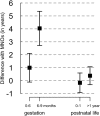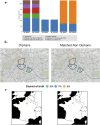Prenatal loss of father during World War One is predictive of a reduced lifespan in adulthood
- PMID: 28377521
- PMCID: PMC5402438
- DOI: 10.1073/pnas.1617911114
Prenatal loss of father during World War One is predictive of a reduced lifespan in adulthood
Abstract
Although early-life stress is known to alter health, its long-term consequences on mortality remain largely unknown. Thanks to unique French legislation established in 1917 for war orphans and children of disabled soldiers, we were able to study the adult mortality of individuals born in 1914-1916 whose fathers were killed during World War 1. Vital information and socio-demographic characteristics were extracted manually from historical civil registers for 5,671 children born between 1 August 1914 and 31 December 1916 who were granted the status of "pupille de la Nation" (orphan of the Nation). We used a database comprising 1.4 million deceased soldiers to identify war orphans and collect information on their fathers and then paired each orphan with a nonorphan from the same birth register matched for date of birth, sex, and mother's age at the infant's birth. Mortality between ages 31 and 99 y was analyzed for 2,365 orphan/nonorphan pairs. The mean loss of adult lifespan of orphans who had lost their father before birth was 2.4 y (95% CI: 0.7, 3.9 y) and was the result of increased mortality before age 65 y. Adult lifespan was not reduced when the father's death occurred after the infant's birth. These results support the notion that intrauterine exposure to a major psychological maternal stress can affect human longevity.
Keywords: World War One; adult mortality; historical cohort; intrauterine programming; maternal bereavement.
Conflict of interest statement
The authors declare no conflict of interest.
Figures







References
-
- Barker DJP, Winter PD, Osmond C, Margetts B, Simmonds SJ. Weight in infancy and death from ischaemic heart disease. Lancet. 1989;2:577–580. - PubMed
-
- Gluckman P, Hanson M, editors. Developmental Origins of Health and Disease. Cambridge Univ Press; Cambridge,UK: 2006.
Publication types
MeSH terms
LinkOut - more resources
Full Text Sources
Other Literature Sources
Medical

